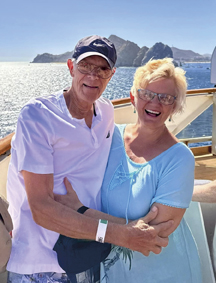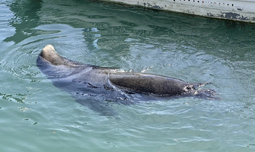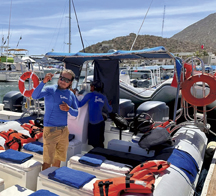
Mexico’s Cabo San Lucas
Who hasn’t heard or seen pictures of Cabo’s world famous natural arch? Cabo San Lucas, also simply known as Cabo, is a resort city at the southern tip of the Baja California peninsula, in the Mexican state of Baja. Rated as one of Mexico’s top tourist destinations, Cabo is a modern and sophisticated tourist destination and a magnet for golf, diving and sport fishing enthusiasts, as well as those that just want to enjoy the sun, beaches and the spectacular natural setting that mixes desert and the warm emerald sea. We were excited to finally get to experience Cabo personally for the first time, though it was only for a day as part of our cruise port’s agenda.
 From the United States, there are many direct and non-stop flights to Cabo, including New York. The Los Cabos International Airport serves the Los Cabos area and is the sixth busiest airport in Mexico. San Jose del Cabo and Cabo San Lucas make up Los Cabos, which translates to ‘The Capes’, and each of them is one of the two Capes. Cabo was on the itinerary, as one of our port days, after our Panama canal crossing and up the West Coast on Holland America’s MS Eurodam. Due to the absence of an official cruise terminal in Cabo San Lucas, cruise ships must anchor a short distance offshore and tender to the marina.
From the United States, there are many direct and non-stop flights to Cabo, including New York. The Los Cabos International Airport serves the Los Cabos area and is the sixth busiest airport in Mexico. San Jose del Cabo and Cabo San Lucas make up Los Cabos, which translates to ‘The Capes’, and each of them is one of the two Capes. Cabo was on the itinerary, as one of our port days, after our Panama canal crossing and up the West Coast on Holland America’s MS Eurodam. Due to the absence of an official cruise terminal in Cabo San Lucas, cruise ships must anchor a short distance offshore and tender to the marina.
 I had seen Cabo’s famous ‘Arch of Cabo San Lucas’ many times in pictures, but never in person. When the MS Eurodam approached Cabo’s ‘Land’s End’ and its famous rock formations came into sight, it truly took my breath away. It’s said that it took over a million years for the oceans to form “El Arco”, and under a bluer than blue sky and surrounded by turquoise water within the confluence of the Pacific Ocean and Sea of Cortez, it was a breathtaking sight.
I had seen Cabo’s famous ‘Arch of Cabo San Lucas’ many times in pictures, but never in person. When the MS Eurodam approached Cabo’s ‘Land’s End’ and its famous rock formations came into sight, it truly took my breath away. It’s said that it took over a million years for the oceans to form “El Arco”, and under a bluer than blue sky and surrounded by turquoise water within the confluence of the Pacific Ocean and Sea of Cortez, it was a breathtaking sight.
 The waters surrounding Cabo are teeming with marine life, such as rays, sharks, mahi-mahi, and striped marlin. The southern tip of Baja is home to sea lions and stingrays as well, and is a great place for snorkeling and seeing tropical fish up close. Holland America’s tender brought us to Cabo’s harbor within minutes, where we were welcomed by a sea lion. Our group was greeted by the captain of a large Apex speed boat, and his friendly tour guide took us to the facility where we were fitted with snorkeling gear.
The waters surrounding Cabo are teeming with marine life, such as rays, sharks, mahi-mahi, and striped marlin. The southern tip of Baja is home to sea lions and stingrays as well, and is a great place for snorkeling and seeing tropical fish up close. Holland America’s tender brought us to Cabo’s harbor within minutes, where we were welcomed by a sea lion. Our group was greeted by the captain of a large Apex speed boat, and his friendly tour guide took us to the facility where we were fitted with snorkeling gear. 
 The captain and guide, who assess the daily conditions, picked a location best suitable for snorkeling and least crowded that morning. We traversed Cabo’s famed Land’s End arch and Lover’s white sandy beach for close up views. Next, we donned our snorkel gear and dove into the warm waters that Jacques-Yves Cousteau had nicknamed the ‘Aquarium of the World’. There aren’t many sports that connect one to nature in the way snorkeling does. Though largely recreational, snorkeling has many positive health benefits, from muscle strength and stress relief to increased cardiovascular fitness.
The captain and guide, who assess the daily conditions, picked a location best suitable for snorkeling and least crowded that morning. We traversed Cabo’s famed Land’s End arch and Lover’s white sandy beach for close up views. Next, we donned our snorkel gear and dove into the warm waters that Jacques-Yves Cousteau had nicknamed the ‘Aquarium of the World’. There aren’t many sports that connect one to nature in the way snorkeling does. Though largely recreational, snorkeling has many positive health benefits, from muscle strength and stress relief to increased cardiovascular fitness.
 In terms of history, archaeological excavations have revealed evidence of human habitation in the area for at least 10,000 years. When the first Europeans arrived, they encountered the Pericú people, who survived on a subsistence diet based on hunting and gathering seeds, roots, shellfish, and other marine resources. They called the place Yenecamú. According to the narrative of Hatsutaro, a Japanese castaway, in the book Kaigai Ibun, when he arrived at Cabo San Lucas in May 1842, there were only two houses and around 20 inhabitants. But, American authors such as Henry Edwards and John Ross Browne claim that Cabo San Lucas’s founder was an Englishman named Thomas “Old Tom” Ritchie. According to John Ross Browne, Ritchie arrived there in 1828, but Edwards states that he died in October 1874. The actual founder of Cabo San Lucas was Cipriano Ceseña who arrived from Hermosillo, Sonora in 1788. Per the book by Pablo L. Martinez, Guia Familiar de Baja California, 1700–1900.
In terms of history, archaeological excavations have revealed evidence of human habitation in the area for at least 10,000 years. When the first Europeans arrived, they encountered the Pericú people, who survived on a subsistence diet based on hunting and gathering seeds, roots, shellfish, and other marine resources. They called the place Yenecamú. According to the narrative of Hatsutaro, a Japanese castaway, in the book Kaigai Ibun, when he arrived at Cabo San Lucas in May 1842, there were only two houses and around 20 inhabitants. But, American authors such as Henry Edwards and John Ross Browne claim that Cabo San Lucas’s founder was an Englishman named Thomas “Old Tom” Ritchie. According to John Ross Browne, Ritchie arrived there in 1828, but Edwards states that he died in October 1874. The actual founder of Cabo San Lucas was Cipriano Ceseña who arrived from Hermosillo, Sonora in 1788. Per the book by Pablo L. Martinez, Guia Familiar de Baja California, 1700–1900.
Today, Cabo San Lucas is a well-known vacation spot that boasts the highest-paying marlin tournament in the world, the Bisbee’s Los Cabos Offshore. This tournament takes place every year in the month of October. In the winter months, pods of whales may be observed in the area. They give birth to their calves in the warm waters of the Gulf of California after traveling up to 6,000 miles from Alaska and Siberia.
On our return to shore, we found homemade cheese tortillas, beans, guacamole, and a spicy red sauce waiting for us as a part of our Holland America snorkel excursion. We all dug in and then it was time to return to the pier and catch the next tender to bring us back on board the beautiful MS Eurodam. Once aboard, Captain Marc Trembling announced that Deck 5 would again be open for a sail-away party, complete with fresh mango margaritas and a last look at Cabo’s famous rocks.
Until next month from another interesting location.
— Yours in travel, Ingrid
Escape From Paradise: www.EscapeFromParadise.net
www.facebook.com/ingrid.lemme #EscapeFromParadise
Award-winning TV Host, Publisher, Travel Writer.
Ambassador for www.Seven-Stars.com & 15 Emmy awards www.aTasteofHistory.org
www.twitter.com/LemmeEscape www.instagram.com/ingridlemme

